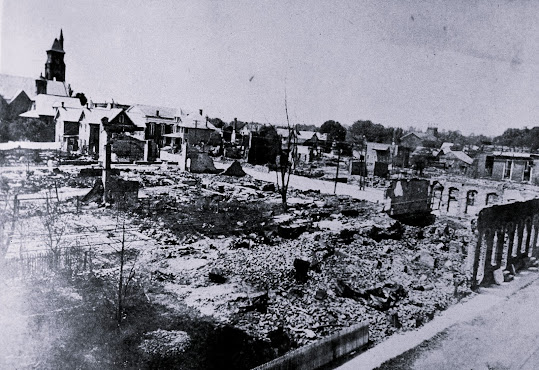Nobody living on "Main Street, Jersey Shore," at the turn of the century could have foreseen, of course, a disaster that struck about 17 years later, the conflagration routing scores from their homes and business places on a bitter-cold December morning, leaving both sides of a long block in ruins. In 1900 many people had their homes and stores in the 200 block of Main, between Smith and Thompson sts. with the awful December blaze still many years away, the bustle part of town was prospering 70 years ago.
The Presbyterian church's relatively new edifice — built 1894 — stood on the corner of Thompson and S. Main Sts. where it does today. Adjacent to the church on the north was the Robert McGowan, residence, the McGowans having no children of their own, but who had living with them a young man by the name of Bruce Williamson .... Then there was the L.E.
Probst home, today the residence of Miss Mary Probst, secretary in the Keystone Short way Association office for so many years, and her brother, William. . . . Seventeen years later they were destined to escape the destruction of the big fire, whose flames ate the Probst and Adam Haas meat market next door.
Gutted next north was the A.I. English residence and grocery, today owned by Mrs. John Brownlee as a home, with an alley between it 70 years ago and the area of the "Seven Kitchens," diminutive dwellings between the east side of Main St. and the alley to the rear. On the corner of the alley and S.Main at the turn of the century was the Mrs. Marge Junod dress shop, she the wife of Sam, and the mother of Harry Junod, who has died in recent years.
Before the 1917 fire - the east side of the second block of South Main Street. Zettles Bakery, Sam Pechter's Dry Goods, Dr Uriah Reed Building housing Mohn's Drug and Stationary store and Millenary shop.
Next came the J.E. Mohn Drug Store in a building replaced by today's Shuman Apartments. The adjoining Elizabeth, Ann, and Lou Miller Sisters dry goods and notions store was burned to the ground, too, but never replaced.
The same held true of the Thompson and Sample green goods and produce store, the Sherman Sample wallpaper and paint store, and the David Cochrane residence, which at the time was being rented to the N.Y. Central civil engineers.
The largest building to be destroyed was the Gamble House Hotel, at the corner of Smith St., and happily the northern extremity of the blaze of 1917. Dave Cochrane was the proprietor in 1900 in happier days, the hotel built by Joseph Gaus, with the help of influential John A. Gamble, and its first proprietor, Andrew Gaus, of whom Mrs. Robert F. Cooney of today's Jersey Shore is a descendant.
During those days of 70 annums ago, there was a horse barn at the rear of the Gamble House, about where Mrs. Irene Kissell now lives on Front St. along the river bank, and at the extreme foot of Smith St., there was a building owned by the borough, the structure extending out over the river and housing fire apparatus- such as it was. You see that was two years before the organization of the Independent Hose Co.
The apparatus consisted of three two-wheel reel carts, and one four-wheel cart, the last the unit to which the firemen could hitch a horse in the event the fire was in the Third or Fourth Wards uptown. And, what's more, the firefighters would press into service the first equine they came upon. No time for formalities.
------------------------------------
One paper named Lieutenant Frederick Johnson as a hero, having spent 5 hours laying on his stomach on the roof of a building with a garden hose. "several times Johnson was nearly overcome. Women then came to his aid, rubbed his stiffened limbs and revived him"
READ MORE
=============













.jpg)
.jpg)
.jpg)
.jpg)


No comments:
Post a Comment
I'll read the comments and approve them to post as soon as I can! Thanks for stopping by!